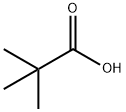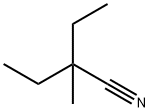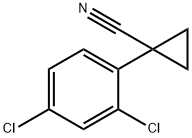Trimethylacetonitrile
Synonym(s):tert-Butyl cyanide;Pivalonitrile
- CAS NO.:630-18-2
- Empirical Formula: C5H9N
- Molecular Weight: 83.13
- MDL number: MFCD00001847
- EINECS: 211-133-0
- SAFETY DATA SHEET (SDS)
- Update Date: 2025-09-25 17:15:13

What is Trimethylacetonitrile?
Description
Trimethylacetonitrile is a colorless and transparent liquid with high polarity and solubility. Its dielectric constant varies with temperature and frequency. At room temperature, the dielectric constant of trimethylacetonitrile is approximately 37.5, which gradually decreases at high temperatures. The high dielectric constant of trimethylacetonitrile makes it widely used in the field of electrochemistry. For example, in electrochemical reactions, trimethylacetonitrile can be used as a solvent and electrolyte to improve the efficiency and rate of the reaction. At the same time, trimethylacetonitrile can also be used as a dielectric for capacitors, to store charge and energy.
Chemical properties
CLEAR COLOURLESS LIQUID
The Uses of Trimethylacetonitrile
Trimethylacetonitrile used as a solvent and as a labile ligand in coordination chemistry. It is also used as an intermediate in organic synthesis. It is used in the presence of titanium(II) chloride and zinc to undergoes reductive coupling reaction of aromatic and aliphatic ketones including acyclic aliphatic ketones to give the corresponding pinacols.
What are the applications of Application
Trimethylacetonitrile can be used:
As an intermediate compound, it is a product of benzopyrimidine in the preparation of 6-substituted phenanthridines[1].
As a laboratory research material for the thermodynamic correlation index determination of chemistry, spectroscopic determination and reduction reaction studies with Grignard reagents[2-4].
Purification Methods
Purify it by a two-stage vacuum distillation and de-gas by the freeze-pump-thaw technique. Store it under vacuum at 0o. TOXIC, use an efficient fume hood. [Beilstein 2 IV 875.]
References
[1] JAN PAWLAS; Mikael B. A One-Pot Access to 6-Substituted Phenanthridines from Fluoroarenes and Nitriles via 1,2-Arynes[J]. Organic Letters, 2002. DOI:10.1021/ol026197c.
[2] T. MOHAMED. Computational (DFT and MP2) and spectral interpretations, normal coordinate analysis, force constants and barriers to internal rotations of Trimethylacetonitrile[J]. Journal of Theoretical & Computational Chemistry, 2016. DOI:10.1142/S0219633616500346.
[3] EDGAR F. WESTRUM JR. Aaron R. Trimethylacetonitrile. Low-temperature heat capacity, vapor pressure, and chemical thermodynamics of the crystalline, liquid, and gaseous phases[J]. The Journal of Physical Chemistry , 1967. DOI:10.1021/j100864a006.
[4] HARRY S. MOSHER; William T M. The Reduction of Trimethylacetonitrile with Grignard Reagents1[J]. Journal of the American Chemical Society, 1951. DOI:10.1021/ja01152a114.
Properties of Trimethylacetonitrile
| Melting point: | 15-16 °C (lit.) |
| Boiling point: | 105-106 °C (lit.) |
| Density | 0.752 g/mL at 25 °C (lit.) |
| refractive index | n |
| Flash point: | 40 °F |
| storage temp. | Sealed in dry,Room Temperature |
| form | Liquid |
| color | Clear colorless |
| Water Solubility | Miscible with ethanol, acetone and toluene. Slightly miscible with water. |
| BRN | 1361449 |
| Exposure limits | NIOSH: IDLH 25 mg/m3 |
| Dielectric constant | 20.09 |
| InChI | InChI=1S/C5H9N/c1-5(2,3)4-6/h1-3H3 |
| CAS DataBase Reference | 630-18-2(CAS DataBase Reference) |
| EPA Substance Registry System | Propanenitrile, 2,2-dimethyl- (630-18-2) |
Safety information for Trimethylacetonitrile
| Signal word | Danger |
| Pictogram(s) |
 Flame Flammables GHS02  Skull and Crossbones Acute Toxicity GHS06 |
| GHS Hazard Statements |
H225:Flammable liquids |
| Precautionary Statement Codes |
P210:Keep away from heat/sparks/open flames/hot surfaces. — No smoking. P233:Keep container tightly closed. P280:Wear protective gloves/protective clothing/eye protection/face protection. P301+P310:IF SWALLOWED: Immediately call a POISON CENTER or doctor/physician. P303+P361+P353:IF ON SKIN (or hair): Remove/Take off Immediately all contaminated clothing. Rinse SKIN with water/shower. |
Computed Descriptors for Trimethylacetonitrile
| InChIKey | JAMNHZBIQDNHMM-UHFFFAOYSA-N |
| SMILES | C(#N)C(C)(C)C |
New Products
Indole Methyl Resin tert-butyl 9-methoxy-3-azaspiro[5.5]undecane-3-carboxylate Boc-His(Boc)-OH 2-CTC Resin 4-Chloro-7-tosy1-7Hpyrrolo[2,3-d]pyrimidine 5,7-Dibromo-1H-indole 2,5-dichloro-N-hydroxy-4,6-dimethylpyridine-3-carboximidamide 2,2-Dimethoxy-7-azaspiro[3.5]nonane hydrochloride 4-chloromethyl-5-methyl-1,3-dioxol-2-one (DMDO-Cl) R-2-BENZYLOXY PROPIONIC ACID 1,1’-CARBONYLDIIMIDAZOLE 1,1’-CARBONYLDI (1,2-4 TRIAZOLE) N-METHYL INDAZOLE-3-CARBOXYLIC ACID 4-((2-hydroxyethyl)thio)benzoic acid 1-(TERT-BUTOXYCARBONYL)-2-PYRROLIDINONE Methyl 6-methylnicotinate 3-Pyridineacrylic acid tert-Butyl carbazate TETRAHYDRO-2H-PYRAN-3-OL 2-((4-morpholinophenylamino) (methylthio) methylene) malononitrile 3-(4-morpholinophenylamino)-5-amino-1H-pyrazole-4-carbonitrile 2,4-dihydroxybenzaldehyde 1,3-Diethyl-1,3-Diphenylurea Methyl 2-methylquinoline-6-carboxylateRelated products of tetrahydrofuran








You may like
-
 Pivalonitrile 98%View Details
Pivalonitrile 98%View Details -
 Pivalonitrile, 97% CAS 630-18-2View Details
Pivalonitrile, 97% CAS 630-18-2View Details
630-18-2 -
 Pivalonitrile CAS 630-18-2View Details
Pivalonitrile CAS 630-18-2View Details
630-18-2 -
 Trimethylacetonitrile 98% CAS 630-18-2View Details
Trimethylacetonitrile 98% CAS 630-18-2View Details
630-18-2 -
 Trimethylacetonitrile CAS 630-18-2View Details
Trimethylacetonitrile CAS 630-18-2View Details
630-18-2 -
 Trimethylacetonitrile CAS 630-18-2View Details
Trimethylacetonitrile CAS 630-18-2View Details
630-18-2 -
 Trimethylacetonitrile (630-18-2)View Details
Trimethylacetonitrile (630-18-2)View Details
630-18-2 -
 Thiourea 99% ARView Details
Thiourea 99% ARView Details
62-56-6
